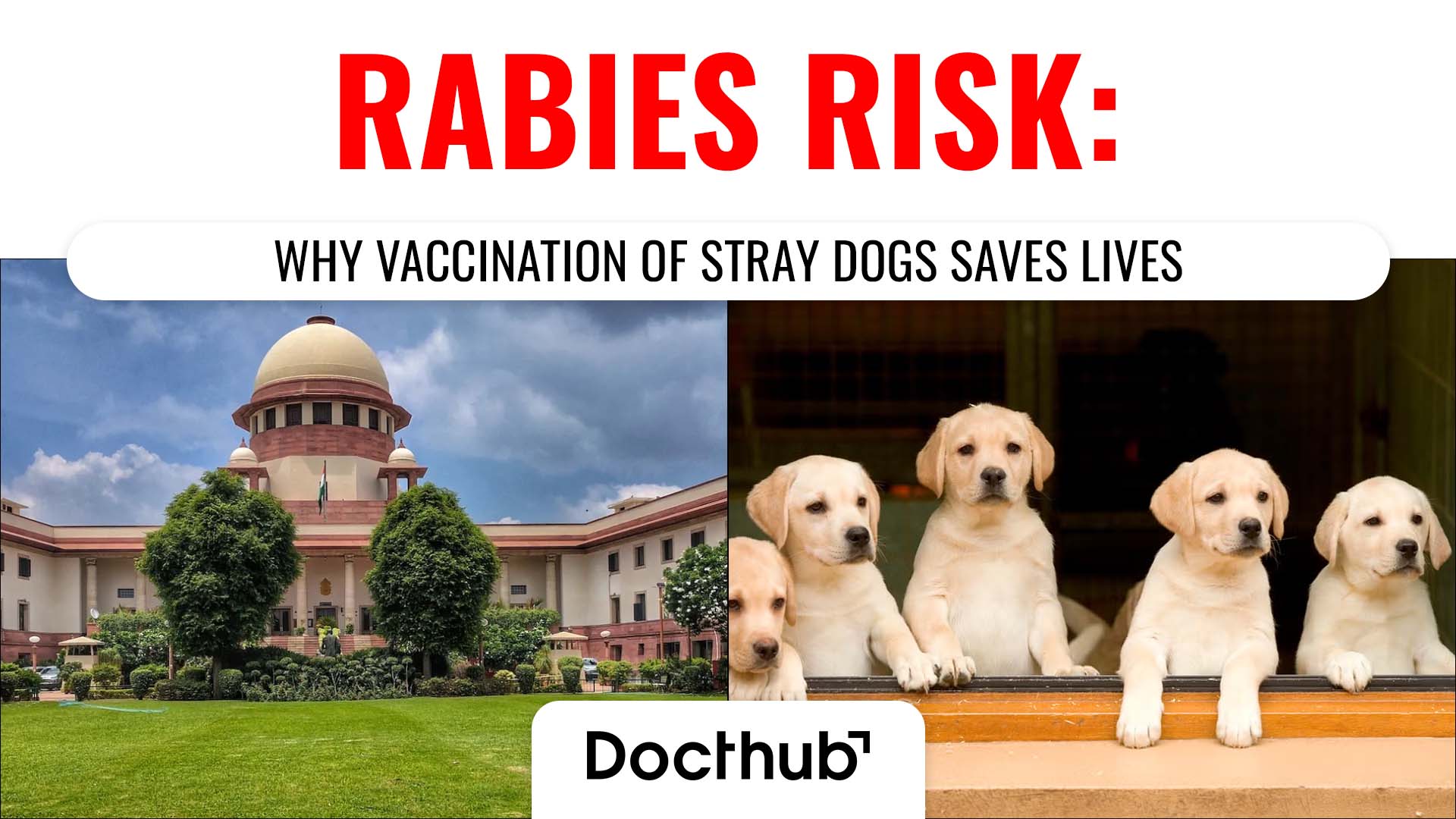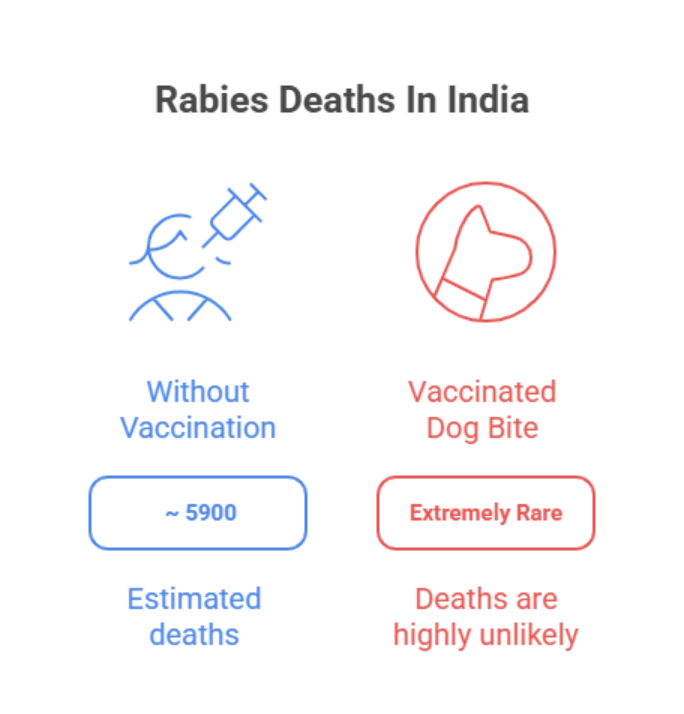Rabies Risk: Why Vaccination of Stray Dogs Saves Lives
Stray dogs on the rise ! A simple act of vaccination can prevent rabies, a deadly disease caused by it.

A few months ago, I observed a pet lover who was badly bitten by a dog and rushed to a hospital. His wife was terrified as no one knew what that dog was up to, whether he had rabies or was vaccinated. Every year, thousands of people lose their lives to this preventable disease. Rabies is not some random, deadly disease that you may have heard about a long time back; it is much more prevalent even today. A recent Delhi stray dog ban has sparked a debate. Whether street dogs should be banned and put in a shelter house or whether they should be vaccinated and sterilised is again a controversial topic. But the incidents of dog bites are real, with statistics showing that every 3 seconds, there is a dog bite and every 3 hours, there is a death caused by rabies. Thus, the threat of deaths due to dog bites is real. And hence, rabies prevention in India is a public health priority. There is rabies death documented each year, especially where stray dogs are still seen in large quantities. According to the WHO, 59000 deaths are occuring from rabies worldwide and approximately 5900 deaths are seen in India. That accounts for around 36% of the global rabies deaths. 99% of rabies cases are transmitted through dogs.

Through this blog, we are focusing on why stray dog vaccination matters, their impact on preventing rabies, and why a career in veterinary public health is in demand.
Rabies in India- A public health crisis:
Shocking figure of 60 million stray dogs!!! Yes, India has the highest number of stray dogs in the world. Major metro cities in India, such as Delhi, Mumbai, Bangalore, Chennai, and Hyderabad, each have over 1-2 lakh stray dogs. This is due to rapid urbanisation, poor sterilisation coverage, which is due to a lack of effective birth control programmes, and neglected pets in the country due to high maintenance costs, relocation, or illness. Rabies in India is mostly transmitted through dogs. Hence, vaccination of stray dogs is vital.
The Animal Welfare Board of India (AWBI) has laid down clear guidelines for humane management of stray dogs through animal birth control (ABC) rules, which focus on sterilisation and vaccination. However, delay in ABC programs and stray dog vaccination programs means millions of stray dogs remain unvaccinated, which increases the risk of rabies transmission.
India aims to ELIMINATE RABIES BY 2030. However, without compiling for the AWBI programs, this seems to be impossible. Zero by 30 is the goal mission for four organisations – the World Health Organisation (WHO), the World Organisation for Animal Health (WOAH), the Food and Agriculture Organisation of the United Nations (FAO), and the Global Alliance for Rabies Control (GARC). All these have joined hands as united Against Rabies collaboration and are determined to reach this goal. It aims that zero human deaths occur due to rabid dogs by 2030, worldwide.
Rabies overview:
Rabies is a preventable viral zoonotic disease transmitted by mammals like bats, dogs, cats, raccoons, skunks, and foxes, but mainly by dogs. The virus is present in the saliva of the animal and is transmitted through a bite or scratch from an animal. It affects the central nervous system and causes inflammation of the brain and spinal cord. Clinically, it presents as:
- Furious rabies: this is the common type of presentation where there is a lot of hyperactivity, aggression, hydrophobia, aerophobia, and hallucinations.
- Paralytic rabies: is characterised by paralysis, gradual loss of muscle control, loss of sensation, and coma.
Once bitten by an infected animal, the person presents at first with mild flu-like symptoms of fever, headache, and general weakness. A tingling, burning, and itching sensation is felt at the sight of the wound. Thus, early symptoms are mostly flu-like and non-specific. However, once the nervous symptoms like agitation, hallucinations, confusion, hydrophobia ( fear of water), aerophobia ( fear of air ), and worst case paralysis are observed, the disease can prove to be fatal if not given immediate treatment. If the sight of the wound is head or neck, the wound is very dangerous and should be immediately addressed to save life. Any wound should be immediately washed with soap and water for 15 minutes to wash the wound away.
Rabies kills! And it kills within 15 days of the attack. Around 60000 deaths occur from rabies each year, and 40% of these are children. It is a fatal disease.
A few important tips to prevent Rabies are:
- Avoid bites from animals
- In case one is bitten by an animal, it should be immediately washed with soap and water for 15 minutes to wash off the virus
- Seek immediate medical advice
- Get dogs vaccinated
- Avoid feeding the unknown animals
- Avoid petting the animals whose history is not known
- Avoid playing with unknown animals
The Power of Stray Dog Vaccination Programs:
Vaccinating stray dogs develops herd immunity. When the large population is immunised against rabies, they are less likely to contract or transmit the disease. Since the disease is not transmitted, it even prevents unvaccinated dogs from contracting rabies. The chain of transmission is broken as there are fewer diseased dogs around. Mass dog vaccination makes it difficult for the disease to spread within the population. It is an effective way to reduce fatal diseases like rabies and reduce mortality caused by this preventable disease.
Goa has successfully eliminated rabies since 2018. The human deaths due to rabies in Goa have not been seen since then. And it is largely due to its mass dog vaccination drive, rabies education, and intense rabies surveillance. Goa has set an example of how rabies is preventable if one follows the stray dog vaccination program seriously.
Heroes that fight against rabies:
- Veterinary public health specialist is a veterinarian who has specialised in public health, and they deal with prevention, control and treatment of zoonotic diseases. (diseases that are transmitted from animals to humans) They apply their veterinary science to protect and improve human well-beings.
- Field Epidemiologist are crucial in rabies prevention as they identify the high-risk areas, investigate suspected cases, maintain a robust surveillance system, and deploy a rapid response team at the targeted site.
- NGO program manager plays a vital role in countries like India, where they understand the problem, identify it, and make plans and implement the rabies prevention program. They know the challenges and still initiate the mass vaccination drive under team leadership and management.
To build a Career in Rabies prevention, one needs to have the following qualifications :
Qualifications that can be used to fight against rabies:
Master of Public Health (MPH) programs
Diploma in Veterinary Public Health
Explore Docthub to find the right course for you in veterinary science if you are an animal lover or wish to make a difference in public health.
How can we contribute as a community to eradicate rabies:
- Professional level:
Take up Veterinary public health as a career and volunteer for a mass vaccination drive initiated by either the government or NGOs.
Networking within the field to increase awareness of rabies vaccination in India.
- Community level:
Supporting the local vaccination drive
Be a responsible pet owner
Avoid contact with an unknown dog
Report any unusual behaving animal that you see around
Spread rabies awareness amongst people
FAQS:
Q1. How can pursuing veterinary science help in rabies prevention programs?
A. By pursuing veterinary science an individuals can gain the medical knowledge and practical skills needed to diagnose, treat, and prevent diseases like rabies in animals. Veterinarians play a central role in rabies control by leading stray dog vaccination programs, ensuring compliance with Animal Birth Control (ABC) protocols, and educating communities about rabies transmission.
Q2. What qualifications are needed to work in animal vaccination and disease control?
A. To work in animal vaccination and disease control, the most common qualification needed are following:
Bachelor’s degree in Veterinary Science and Animal Husbandry (B.V.Sc & AH)
Training in epidemiology, public health, or animal welfare
Master of Public Health (MPH) programs
Diploma in Veterinary Public Health
Q3. Which public health careers involve rabies surveillance and outbreak prevention?
A. Careers in Veterinary Public Health, Epidemiology are directly involved in rabies surveillance and outbreak prevention. Positions like Veterinary Public Health Specialist, Field Epidemiologist, and Disease Surveillance Officer are in demand across government agencies, research institutions, and NGOs. These careers often involve collaboration with both human and animal health sectors, making them critical to India’s One Health approach to controlling zoonotic diseases.
Q4. How can NGOs and government agencies hire professionals for stray dog vaccination drives?
A. NGOs and government agencies hire professionals for stray dog vaccination drives by hiring professional through public job postings, veterinary colleges, and partnerships with training institutes. Professionals with backgrounds in public health, epidemiology, or veterinary science are preferred to ensure that the drives align with national rabies prevention policies and ethical treatment standards.
Q5. What training programs prepare healthcare workers for zoonotic disease management?
A. Healthcare workers can pursue various training programs focused on zoonotic disease management, including the Master of Public Health (MPH) with a specialization in Epidemiology or One Health, the Diploma in Veterinary Public Health, and the PG Diploma in Epidemiology offered by institutions like NIHFW or IGNOU.








